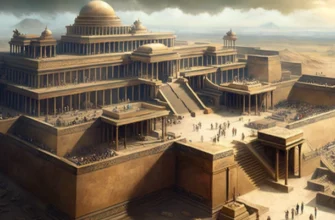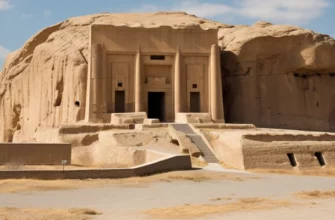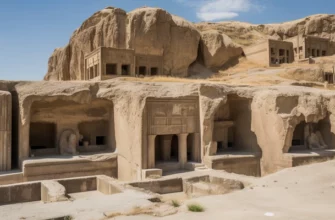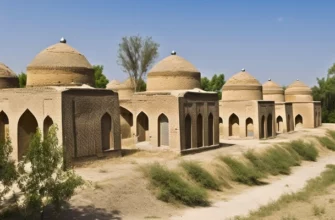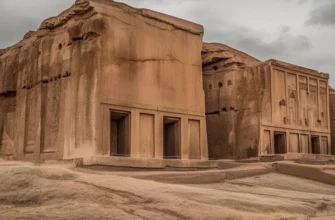Anahita is one of the most important goddesses in the ancient Iranian pantheon. Her cult had deep roots in Iranian history and culture, and she was an important figure in religious rituals and myths.
Anahita, also known as Anahit, comes from an ancient Iranian mythological context. Her cult originated before the creation of Zoroastrianism and was actively spread during the Achaemenid and Sassanid periods. Anahita was the goddess of water, fertility, and motherhood, symbolizing vitality and sustenance. She was an important figure in purification rituals and harvest celebrations.
Anahita was often depicted with attributes of water, such as fish or rivers. Her depictions in art usually show her as a majestic and benevolent goddess, emphasizing her role in providing vital resources. The symbolism of water was associated with purity, fertility, and new life.
Anahita was often mentioned in ancient Iranian literary sources, including epic poems and religious texts. Her cult continued to influence religious traditions even after the spread of Zoroastrianism. In modern culture, Anahita retains her place as a symbol of water and fertility, and her image is sometimes mentioned in literature and cultural studies.
Anahita is a key figure in ancient Iranian religion, symbolizing life force and sustenance. Her influence on Iranian religious practices and culture remains an important subject of study today.
The significance of Anahita in Iranian mythology
Anahita occupies an important place in Iranian mythology as the goddess of water, fertility, and motherhood. Her significance can be examined through several key aspects:
Goddess of water and fertility: Anahita is associated with water resources, which were critical to agriculture and survival in ancient Iran. As a goddess of fertility, she ensured abundant harvests and promoted the fruitfulness of the land.
Symbol of motherhood: Anahita was also a symbol of motherhood and protection. Her cult often included rituals that ensured the protection and well-being of families, emphasizing her role as a protector and nurturer.
Purification and rituals: Anahita played a key role in purification rituals, which were important for maintaining spiritual and physical purity. Her name was often mentioned in the context of rites related to the purification of water and the use of water in religious practices.
Cult and worship: The cult of Anahita was widespread during the Achaemenid and Sassanid periods. Her temples and shrines were important centers of religious life, and her worship was important for maintaining the balance between humans and nature.
Mythological context: Anahita is part of a broad Iranian mythological context, where she interacts with other deities and characters, emphasizing her importance in the religious and cultural beliefs of the ancient Iranians.
Overall, Anahita was not only an important goddess in religious rituals, but also a symbol of the forces of nature that had a direct impact on people’s lives.
Origin and Role of Anahita
Anahita, also known as Anahit, has ancient origins that can be traced back to early Iranian mythology and religion. Her cult probably originated before the development of Zoroastrianism, in the context of Indo-Iranian religious traditions. Anahita appears in sources dating from the Achaemenid (550–330 BC) and Sassanid (224–651 AD) periods, indicating her enduring popularity.
Goddess of water and fertility: Anahita was associated with water resources, which were vital to the agrarian societies of ancient Iran. Her rituals were often aimed at ensuring abundant harvests and maintaining the fertility of the land. Water, which was a symbol of life force, represented Anahita as a source of blessing and vitality.
Mother figure: Anahita was also an important goddess of motherhood and protection. As a mother, she provided support and protection for families and communities. Her rituals included prayers for the health and well-being of people, emphasizing her role as a protector and nurturer.
Rituals of purification: Anahita played an important role in rituals of purification. Purification with water was a key aspect of religious practices, and Anahita provided purity and spiritual cleansing. She was a central figure in rituals that involved the use of water for purification, emphasizing her connection with purity and holiness.
Cult and worship: The cult of Anahita was widespread in ancient Iran. Her temples and shrines were important centers of religious life, and worship of her was essential for maintaining harmony and well-being. Her rituals and ceremonies were part of daily life and religious practice.
In the general context, Anahita was not only a deity who controlled the forces of nature, but also an important part of the religious and cultural beliefs of ancient Iran, emphasizing the importance of water, fertility, and motherhood in the life of society.
Historical context
Anahita, one of the key goddesses of ancient Iran, has deep historical roots that can be traced through several important historical stages and cultural influences:
Ancient Iran: Anahita belongs to the early Iranian religious tradition that preceded the formation of Zoroastrianism. Her cult arose within the framework of Indo-Iranian religious beliefs, where she reflected the importance of water and fertility for an agrarian society. She is part of the ancient Iranian pantheon, which also includes other deities who controlled natural phenomena and ensured social harmony.
Achaemenids (550–330 BC): During the reign of the Achaemenids, Anahita was one of the key deities whose worship was widespread. The Achaemenid dynasty supported a variety of religious practices and cults, including the cult of Anahita, reflecting her importance to the empire. Anahita may have been revered as a deity who provided the water resources and fertility necessary to sustain the empire’s agrarian economy.
Sassanids (224–651 CE): During the Sassanid period, Anahita remained an important figure in the religious life of Iran. Her cult was integrated into official religious practice alongside Zoroastrianism, and she continued to be an object of worship. The Sassanid period was characterized by the restoration and preservation of ancient religious traditions, and Anahita was an important part of this process.
Mythological and literary sources: Anahita is mentioned in numerous ancient texts, such as the Avesta, the sacred text of Zoroastrianism, where her role as the goddess of water and fertility is described in religious rituals and prayers. Her depiction in art and literature attests to her importance in the religious and cultural beliefs of the time.
Evolution and legacy: As Iranian religion and culture evolved, the cult of Anahita underwent changes, but her main attributes and symbolism remained influential. Today, Anahita is part of the study of Iran’s history and religious heritage, providing insight into the religious and cultural beliefs of the ancient Iranians.
Thus, Anahita is an important part of Iran’s historical and religious context, highlighting the importance of water, fertility, and motherhood in ancient Iranian society.
Religious role and functions
As one of the leading goddesses of ancient Iran, Anahita played an important religious role and performed several key functions in the religious life of society:
Goddess of water: Anahita was associated with water, which was critically important to agrarian society in ancient Iran. Water was not only necessary for growing crops, but also symbolized purity and holiness. As the goddess of water, Anahita ensured abundant rainfall and irrigation, which was important for maintaining the fertility of the land.
Purification and rituals: Anahita played a central role in purification rituals. Water, which was associated with her, was used to purify the body and soul in religious ritual practices. This included purification before religious ceremonies, as well as in rituals aimed at restoring and maintaining spiritual purity.
Motherhood and protection: Anahita was also the goddess of motherhood and protection. She provided well-being and support for families and communities. Her cult included prayers for the health, happiness, and well-being of people, which emphasized her role as a protector and nurturer. She was important for maintaining harmony in society and ensuring the well-being of families.
Sacred rites and shrines: Anahita was worshipped in numerous shrines and temples. Her cults and rites included offerings and special rituals aimed at securing her blessings and support. Anahita’s shrines were often important religious centers where ceremonies and prayers were held.
Symbolism and significance: Anahita was a symbol of natural forces and divine blessings. Her role in religious practices and myths reflected the importance of water, fertility, and motherhood in the lives of the ancient Iranians. Her symbolism promoted an understanding of natural phenomena and their connection to the divine world.
Thus, Anahita performed key functions in the religious life of ancient Iran, providing support and blessings through her association with water, purification, and motherhood. Her religious role was important for maintaining harmony and well-being in society.
Symbolism and Attributes
As the goddess of water and fertility in ancient Iran, Anahita had a number of symbolic attributes that reflected her role and significance in religious practices:
Water: The primary symbol of Anahita is water. It was critically important to Iran’s agrarian society, so water, associated with Anahita, symbolizes vitality, fertility, and purification. Water also represents the purification of the spirit and body, making it a key element in religious rituals and ceremonies.
Rivers and springs: Anahita was often depicted in connection with rivers and springs. This emphasizes her role as a source of life and fertility. The rivers she protects or lives in symbolize her influence on the natural world and human life.
Fish or water creatures: In some depictions, Anahita is associated with fish or other water creatures. These attributes emphasize her connection to the aquatic environment and her role as protector of water resources.
Depictions in art: In ancient Iranian art, Anahita was often depicted as a majestic woman with elements reminiscent of water resources. Her depictions could include large amounts of water, rivers, or aquatic plants, emphasizing her function as a goddess of water and fertility.
Functional attributes: Anahita may also be depicted with certain ritual objects, such as bowls or vessels for water. These attributes indicate her role in rituals of purification and celebration.
Cult symbols: In religious texts and rituals, Anahita may be mentioned in the context of sacred symbols that include various elements of nature, emphasizing her importance in maintaining harmony and fertility in the natural world.
Symbolic meaning: Anahita’s symbolism emphasizes her important role in providing vital resources and maintaining natural balance. Water, as the source of life, is a key aspect of her worship, and her rituals were often aimed at ensuring the fertility of the land and maintaining spiritual purity.
Thus, through her attributes and symbolism, Anahita reflected the importance of water and fertility in ancient Iran, as well as her role in maintaining harmony and well-being in society.
Reflection in art
Anahita, as the goddess of water and fertility, was often depicted in the art of ancient Iran. Her images and symbolism are reflected through several key elements:
Majestic figure: Anahita was often depicted as a majestic woman, emphasizing her divine status. Her figure could be elegant and graceful, reflecting her role as an important goddess who protects nature and provides life resources.
Water and rivers: Depictions of Anahita often included elements of water, such as rivers or water sources. She might be shown standing or sitting by a river, with water flowing around her or coming out of her hands, symbolizing her control over water resources and fertility.
Fish and water creatures: In some depictions, Anaita is accompanied by fish or other water creatures. This emphasizes her connection to the water world and her role as a divine protector of water.
Ritual objects: Anaita was sometimes depicted with ritual objects such as bowls or water vessels. These objects indicate her involvement in rituals of purification and celebration.
Mythological scenes: In ancient art, Anahita could also be part of mythological scenes where she interacts with other deities or characters. Such depictions helped convey her importance in the context of religious stories and myths.
Architectural reliefs: In some temples and shrines dedicated to Anahita, her images could be carved on reliefs or other architectural elements. These reliefs often depicted scenes of rituals or symbols associated with the cult of the goddess.
Temporary images: Images of Anahita can also be found on ancient Iranian coins or ceramics. Such artifacts served not only as religious symbols but also as elements of everyday life, emphasizing her importance in daily life.
In general, artistic depictions of Anahita emphasize her central role in the religious and cultural practices of ancient Iran. Her images helped to reflect the importance of water and fertility in the life of society and provided religious and cultural identity.
Anahita in literature and culture
As an important goddess of ancient Iran, Anahita has a significant influence not only in religious texts, but also in literature and culture:
Avesta: Anahita is mentioned in the Avesta, the sacred texts of Zoroastrianism, which are the main source of religious information about ancient Iran. In the Avesta, Anahita is described as the goddess of water and fertility, and her role in purification and blessing rituals is described in detail.
Mythological epics: In Persian epic poems and myths, Anahita sometimes appears as an important divine figure who interacts with other deities and heroes. Her images in such texts are often associated with natural phenomena and social rituals.
Persian poems and literary works: Anahita appears in classical Persian literary works, where her role as the goddess of water and fertility is emphasized through metaphors and symbolic imagery. These works often use images of Anahita to convey themes of nature, vitality, and divine blessing.
Celebrations and rituals: In ancient Iranian culture, Anahita was the subject of religious celebrations and rituals. Rituals involving water and purification were often performed in her honor, emphasizing her importance in maintaining harmony and well-being in society.
Art and symbolism: Anahita was often depicted in art as a majestic figure with water attributes. This reflected her connection to natural resources and her role as the patroness of fertility and purity.
Historical and cultural studies: In contemporary studies of Iranian history and culture, Anahita is an important subject of analysis. Her role in the religious and social practices of ancient Iran is examined in the context of her influence on contemporary cultural heritage.
Popular culture: The image of Anahita is sometimes used in contemporary popular culture, literature, and art, reflecting her enduring cultural influence. Her symbolic qualities and mythological representations can appear in various forms of contemporary art and media.
Thus, Anahita has a significant influence on the literature and culture of both ancient Iran and contemporary cultural representations. Her image and symbolism continue to be important for understanding religious and cultural traditions that have their roots in ancient times.
The presence of Anahita in myths and literary sources
Anahita, as an important goddess of ancient Iran, plays a significant role in religious myths and literary sources. Her image and functions are reflected through various texts and mythological narratives:
Avesta: The Avesta is the primary source of information about the religious beliefs of ancient Iran, including the cult of Anahita. In this sacred text, Anahita appears as the goddess of water, fertility, and motherhood. Her role in rituals of purification and blessing is important for maintaining spiritual purity and fertility.
Yasna: Parts of the Avesta, particularly the Yasna, describe rituals and prayers associated with Anahita, emphasizing her importance in religious practices.
Mythological epics and legends:
Myths and legends: Anahita appears in ancient Iranian myths as an important divine figure who interacts with other deities. She may be part of stories involving natural phenomena or social rituals, and often acts as a patron or protector.
Epic poems: In epic poems and mythological works, Anahita may be represented as a character interacting with heroes and deities, for example, in stories about the creation of the world or the struggle against the forces of chaos.
Persian literary works:
Poetry and prose: Anahita is also mentioned in Persian literary works, where her role and attributes may be symbolically represented. Her image may be used to convey themes of nature, fertility, and divine blessing.
Archaeological and literary finds:
Historical texts: Archaeological finds, such as ancient reliefs, statues, and written materials, also confirm Anahita’s presence in religious and cultural practices. These artifacts often depict her in the context of rituals and ceremonies.
Later literary references: After the spread of Zoroastrianism and in medieval Persian literature, Anaita may be mentioned as part of the cultural heritage, noting her lasting influence on literary and religious traditions.
Thus, Anahita is present in various myths and literary sources as an important divine figure symbolizing water resources, fertility, and purification. Her image and functions were important to the religious and cultural identity of ancient Iran and continue to be the subject of study in history and literature.
Conclusion
The study of Anahita is of great importance for understanding Iranian culture and religion. Anahita, as an important goddess of ancient Iran, reflects religious ideas about water and fertility, which had a significant impact on everyday life and social practices.
Anahita is an important element of the early religious tradition that preceded Zoroastrianism. Her cult helps to reveal how the ancient Iranians perceived nature and its elements, as well as how these beliefs shaped their religious practices. The images and symbols associated with Anaita in art and literature provide a deeper understanding of the cultural beliefs and rituals of the time.
Research on Anaita also contributes to the restoration of Iran’s cultural heritage, helping to preserve and pass on knowledge of ancient traditions to future generations. Studying her role and significance can influence contemporary cultural and spiritual practices, highlighting the importance of environmental and spiritual aspects.
It is also important to note that Anaita studies bring together various academic disciplines, such as history, mythology, archaeology, and literary studies, contributing to a comprehensive understanding of Iranian culture and religion. Anaita is a key element in revealing the richness and complexity of ancient Iranian beliefs and traditions.

